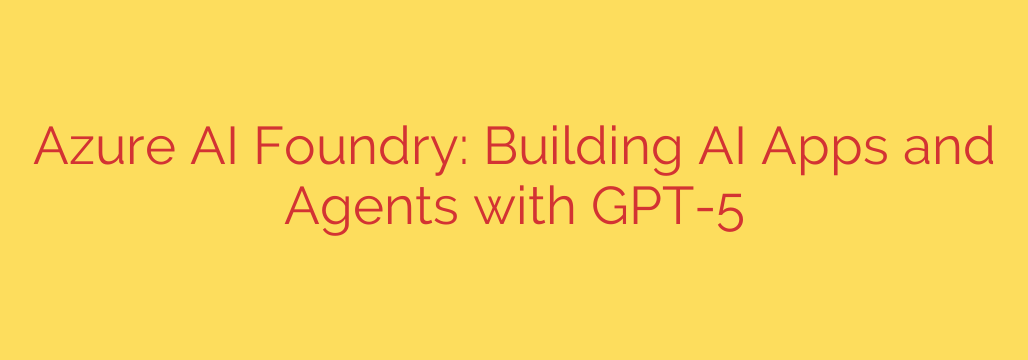
Azure AI Foundry: The New Hub for Building Custom, Next-Generation AI Applications
The race to integrate artificial intelligence into business operations is on, but many organizations face a significant hurdle: the complexity of building, customizing, and safely deploying AI models. To bridge this gap, Microsoft has introduced a powerful new ecosystem designed to streamline the entire AI development lifecycle: Azure AI Foundry. This platform serves as a central hub for developers and businesses looking to build sophisticated AI apps and agents with cutting-edge technology.
Azure AI Foundry isn’t just a single tool; it’s a comprehensive solution that brings together state-of-the-art AI models, powerful development tools, and the enterprise-grade infrastructure of Azure. It aims to democratize access to advanced AI, enabling more organizations to move from concept to production with greater speed and confidence.
The Three Pillars of AI Foundry
The platform is built on three core principles, each designed to address a critical stage of the AI development process.
1. Access to a Premier Catalog of AI Models
At the heart of any AI application is the model itself. Azure AI Foundry provides an extensive catalog of leading AI models, including both proprietary and open-source options. This gives developers unparalleled flexibility to choose the right foundation for their specific needs.
The selection includes:
- Frontier Models: Access to the latest and most powerful models from industry leaders like OpenAI, including future advancements like GPT-5 and other next-generation architectures.
- Open-Source Champions: The ability to leverage popular open-source models from providers like Meta (Llama family), Mistral, and Cohere.
- Microsoft’s Own Models: A suite of high-performance models developed by Microsoft Research.
Crucially, the platform isn’t just about providing access. It offers powerful fine-tuning capabilities, allowing you to adapt these powerful base models with your own company data. This process creates a custom model that understands your specific business context, terminology, and customer needs, resulting in significantly more accurate and relevant outputs.
2. A Unified and Streamlined Toolchain
Building an AI app involves much more than just selecting a model. It requires a robust set of tools for prompting, testing, evaluating, and deploying. Azure AI Foundry integrates these functions into a seamless workflow within Azure AI Studio.
This unified environment helps teams:
- Develop and Refine Prompts: Use tools like Prompt Flow to visually design, test, and optimize the instructions given to the AI, ensuring reliable and consistent performance.
- Evaluate Model Performance: Go beyond simple observation with sophisticated evaluation metrics. The platform provides tools to systematically measure the quality, safety, and accuracy of your model’s responses before it ever reaches a customer.
- Manage the End-to-End Lifecycle: From initial experimentation and fine-tuning to deployment and ongoing monitoring, the entire process is managed in one place. This drastically reduces the complexity of MLOps (Machine Learning Operations).
By bringing these tools together, the platform helps eliminate the fragmented, multi-tool approach that often slows down AI projects, making the path to production smoother and more efficient.
3. Enterprise-Grade Security and Responsible AI
For any serious business application, security, scalability, and responsible implementation are non-negotiable. Azure AI Foundry is built on the robust foundation of Microsoft Azure, offering the same enterprise-grade security, compliance, and data privacy that global organizations trust.
Furthermore, it integrates Microsoft’s Responsible AI (RAI) framework directly into the development process. This includes:
- Built-in Safety Filters: Tools to detect and mitigate harmful content, jailbreak attempts, and other risks.
- Content Provenance: Features that help ensure transparency and traceability in AI-generated content.
- Monitoring and Auditing: The ability to continuously monitor your deployed applications for safety and performance issues.
This deep integration of responsible AI principles ensures that businesses can innovate with confidence, knowing their applications are built to be safe, fair, and reliable.
Actionable Security and Implementation Tips
As you explore building on this platform, keep these best practices in mind:
- Start with a Defined Use Case: Before fine-tuning a model, clearly define the problem you are trying to solve. A focused goal will guide your data selection and evaluation process.
- Prioritize High-Quality Data: The success of a custom, fine-tuned model depends entirely on the quality of the data you provide. Ensure your training data is clean, relevant, and representative of the tasks the AI will perform.
- Leverage Responsible AI Tools from Day One: Don’t treat safety and responsibility as an afterthought. Use the built-in content filters and evaluation dashboards throughout the development process, not just before deployment.
- Iterate and Evaluate Continuously: AI development is not a one-and-done process. Use the platform’s evaluation tools to regularly test your model against new data and scenarios to catch performance degradation or emerging risks.
By centralizing access to top-tier models, providing a unified toolchain, and embedding enterprise-grade security, Azure AI Foundry is positioned to become the definitive platform for organizations looking to build the next generation of custom AI applications and agents. It marks a significant step toward making sophisticated AI development more accessible, secure, and impactful for businesses everywhere.
Source: https://azure.microsoft.com/en-us/blog/gpt-5-in-azure-ai-foundry-the-future-of-ai-apps-and-agents-starts-here/








